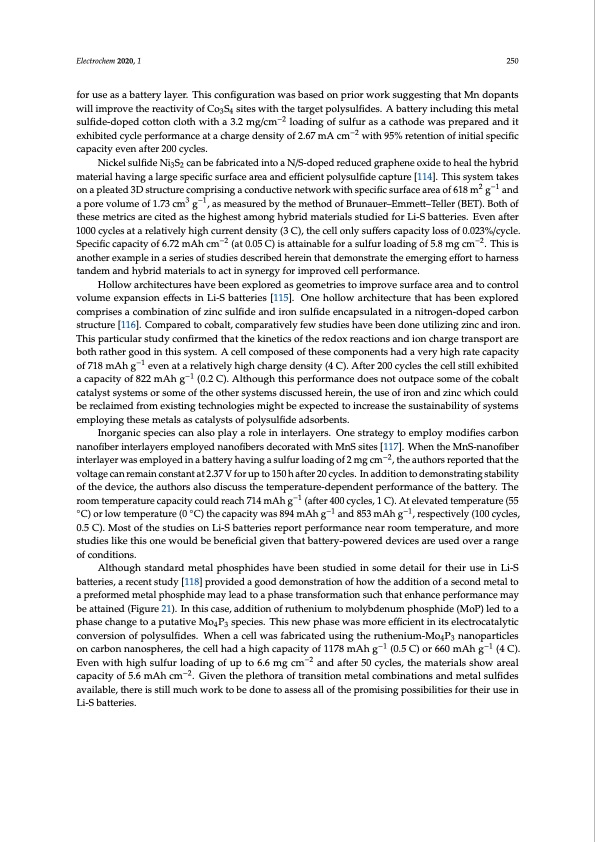
PDF Publication Title:
Text from PDF Page: 025
Electrochem 2020, 1 250 for use as a battery layer. This configuration was based on prior work suggesting that Mn dopants will improve the reactivity of Co3S4 sites with the target polysulfides. A battery including this metal sulfide-doped cotton cloth with a 3.2 mg/cm−2 loading of sulfur as a cathode was prepared and it exhibited cycle performance at a charge density of 2.67 mA cm−2 with 95% retention of initial specific capacity even after 200 cycles. Nickel sulfide Ni3S2 can be fabricated into a N/S-doped reduced graphene oxide to heal the hybrid material having a large specific surface area and efficient polysulfide capture [114]. This system takes on a pleated 3D structure comprising a conductive network with specific surface area of 618 m2 g−1 and a pore volume of 1.73 cm3 g−1, as measured by the method of Brunauer–Emmett–Teller (BET). Both of these metrics are cited as the highest among hybrid materials studied for Li-S batteries. Even after 1000 cycles at a relatively high current density (3 C), the cell only suffers capacity loss of 0.023%/cycle. Specific capacity of 6.72 mAh cm−2 (at 0.05 C) is attainable for a sulfur loading of 5.8 mg cm−2. This is another example in a series of studies described herein that demonstrate the emerging effort to harness tandem and hybrid materials to act in synergy for improved cell performance. Hollow architectures have been explored as geometries to improve surface area and to control volume expansion effects in Li-S batteries [115]. One hollow architecture that has been explored comprises a combination of zinc sulfide and iron sulfide encapsulated in a nitrogen-doped carbon structure [116]. Compared to cobalt, comparatively few studies have been done utilizing zinc and iron. This particular study confirmed that the kinetics of the redox reactions and ion charge transport are both rather good in this system. A cell composed of these components had a very high rate capacity of 718 mAh g−1 even at a relatively high charge density (4 C). After 200 cycles the cell still exhibited a capacity of 822 mAh g−1 (0.2 C). Although this performance does not outpace some of the cobalt catalyst systems or some of the other systems discussed herein, the use of iron and zinc which could be reclaimed from existing technologies might be expected to increase the sustainability of systems employing these metals as catalysts of polysulfide adsorbents. Inorganic species can also play a role in interlayers. One strategy to employ modifies carbon nanofiber interlayers employed nanofibers decorated with MnS sites [117]. When the MnS-nanofiber interlayer was employed in a battery having a sulfur loading of 2 mg cm−2, the authors reported that the voltage can remain constant at 2.37 V for up to 150 h after 20 cycles. In addition to demonstrating stability of the device, the authors also discuss the temperature-dependent performance of the battery. The room temperature capacity could reach 714 mAh g−1 (after 400 cycles, 1 C). At elevated temperature (55 ◦C) or low temperature (0 ◦C) the capacity was 894 mAh g−1 and 853 mAh g−1, respectively (100 cycles, 0.5 C). Most of the studies on Li-S batteries report performance near room temperature, and more studies like this one would be beneficial given that battery-powered devices are used over a range of conditions. Although standard metal phosphides have been studied in some detail for their use in Li-S batteries, a recent study [118] provided a good demonstration of how the addition of a second metal to a preformed metal phosphide may lead to a phase transformation such that enhance performance may be attained (Figure 21). In this case, addition of ruthenium to molybdenum phosphide (MoP) led to a phase change to a putative Mo4P3 species. This new phase was more efficient in its electrocatalytic conversion of polysulfides. When a cell was fabricated using the ruthenium-Mo4P3 nanoparticles on carbon nanospheres, the cell had a high capacity of 1178 mAh g−1 (0.5 C) or 660 mAh g−1 (4 C). Even with high sulfur loading of up to 6.6 mg cm−2 and after 50 cycles, the materials show areal capacity of 5.6 mAh cm−2. Given the plethora of transition metal combinations and metal sulfides available, there is still much work to be done to assess all of the promising possibilities for their use in Li-S batteries.PDF Image | Lithium-Sulfur Batteries: Advances and Trends

PDF Search Title:
Lithium-Sulfur Batteries: Advances and TrendsOriginal File Name Searched:
electrochem-01-00016.pdfDIY PDF Search: Google It | Yahoo | Bing
Sulfur Deposition on Carbon Nanofibers using Supercritical CO2 Sulfur Deposition on Carbon Nanofibers using Supercritical CO2. Gamma sulfur also known as mother of pearl sulfur and nacreous sulfur... More Info
CO2 Organic Rankine Cycle Experimenter Platform The supercritical CO2 phase change system is both a heat pump and organic rankine cycle which can be used for those purposes and as a supercritical extractor for advanced subcritical and supercritical extraction technology. Uses include producing nanoparticles, precious metal CO2 extraction, lithium battery recycling, and other applications... More Info
| CONTACT TEL: 608-238-6001 Email: greg@infinityturbine.com | RSS | AMP |